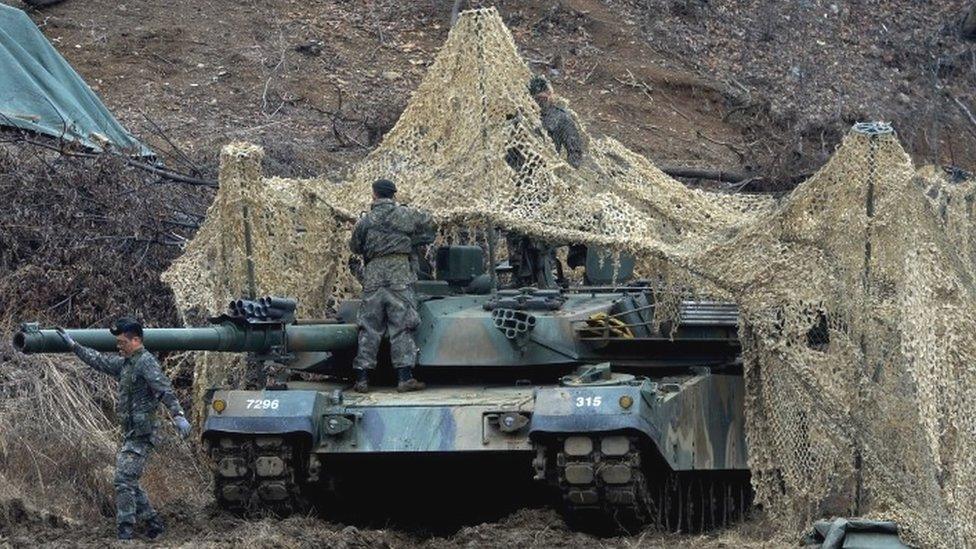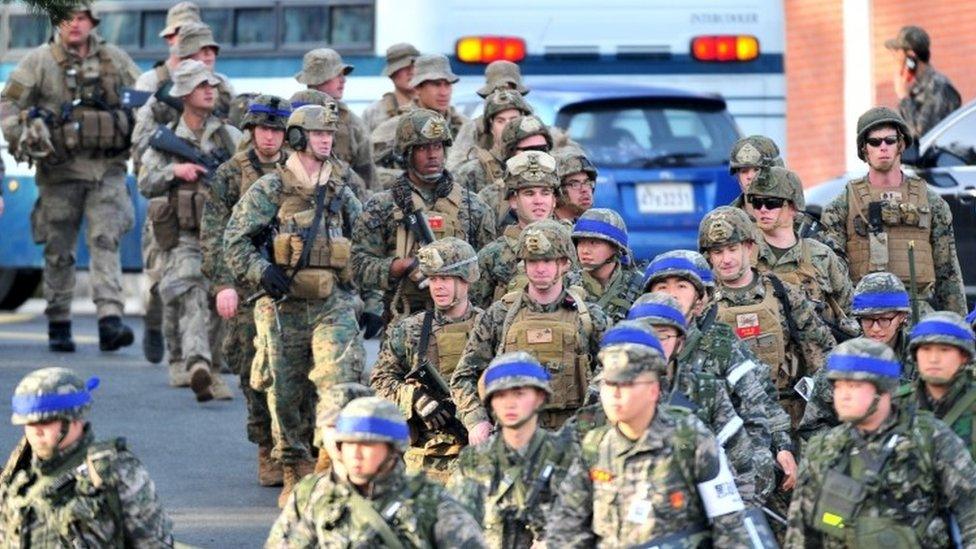North Korea threatens US and S Korea with nuclear strikes
- Published

Significantly more US and South Korean troops are taking part in this year's joint exercises
North Korea has threatened "indiscriminate" nuclear strikes on the US and South Korea as the two begin their largest ever military drills.
The exercises, Key Resolve and Foal Eagle, are an annual event and always generate tension.
The order for a "pre-emptive nuclear strike of justice" was made in a statement put out by Pyongyang.
Such rhetoric is not uncommon, and experts doubt the North's ability to put nuclear warheads on its missiles.
North Korea says it sees the annual US-South Korean war games as a rehearsal for invasion. Last year, it threatened to turn Washington into a "sea of fire".
"We will launch an all-out offensive to decisively counter the US and its followers' hysteric[al} nuclear war moves," a newsreader on the state-run North Korean KRT news channel said of the latest exercises.
Can South Korea defend itself?
Dealing with the North: Carrots or sticks?
How advanced is North Korea's nuclear programme?
Approximately 17,000 US forces are participating in the exercises, alongside around 300,000 South Korean troops - both significant increases on 2015's numbers.
Despite starting on the same day, Key Resolve is more computer simulation-driven and ends on 18 March, while Foal Eagle is more focussed on field exercises and runs until 30 April.

The Key Resolve and Foal Eagle joint exercises are an annual event and always generate tension

The amphibious assault vessel USS Bonhomme Richard (right) and the USS Ashland are taking part

Close to 30,000 US troops are permanently stationed in South Korea
The South's defence ministry has warned Pyongyang against any "rash act that brings destruction upon itself".
"If North Korea ignores our warning and makes provocations, our military will firmly and mercilessly respond to it," said spokesman Moon Sang-gyun.
Japan's foreign minister also demanded that North Korea show restraint.
North Korean news said the US would be "held accountable" if a war started on the Korean peninsula
"North Korea's nuclear, and nuclear missile development is absolutely unacceptable. We will coordinate with the international community to demand that North Korea show restraint, and abide by the various resolutions including that of the six party talks," said Fumio Kishida.
Though unconfirmed, South Korea's Yonhap news agency, citing military sources, has reported that the exercises will include training for precision attacks on North Korean leadership and its nuclear and missile facilities.
These latest exercises come just days after the UN passed new sanctions against North Korea following its recent nuclear test and rocket launch.
On Saturday, the Philippines impounded a North Korean cargo vessel under the toughened measures. A presidential spokesman said the crew would be deported and the ship subject to a UN-mandated inspection.

The exercises also brought out peace protesters in Seoul
The North responded to the sanctions by saying it was readying nuclear weapons for "pre-emptive" use, and by firing short-range missiles into the sea.
Seoul is expected to announce more sanctions of its own on Tuesday, which is likely to draw another angry response from Pyongyang.
The US and South Korea on Friday also began formal talks on the deployment of a US missile defence system to the peninsula, a move strongly opposed by North Korea, Russia and China.
Beijing says the Thaad anti-missile system compromises its security and would undermine its nuclear deterrent.

What is the Terminal High Altitude Area Defense System (Thaad)?
Shoots down short and medium-range ballistic missiles in the terminal phase of their flight
Uses hit-to-kill technology - where kinetic energy destroys the incoming warhead
Has a range of 200km and can reach an altitude of 150km
US has previously deployed it in Guam and Hawaii as a measure against potential attacks from North Korea

1. The enemy launches a missile
2. The Thaad radar system detects the launch, which is relayed to command and control
3. Thaad command and control instructs the launch of an interceptor missile
4. The interceptor missile is fired at the enemy projectile
5. The enemy projectile is destroyed in the terminal phase of flight
The launcher trucks can hold up to eight interceptor missiles.

- Published4 March 2016

- Published3 March 2016

- Published11 February 2016
